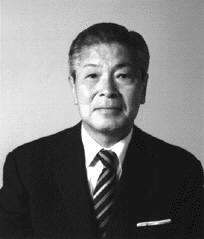Satoshi Sumita
Satoshi Sumita (澄田 智, Sumita Satoshi, September 4, 1916 – September 7, 2008) was a Japanese businessman, central banker, the 25th Governor of the Bank of Japan (BOJ) during a period in which Japan became the world's largest creditor nation.[1]

Early life
Sumita was born in Gunma Prefecture.[2]
Career
In the 1960s, Sumita was made director of the Banking Bureau within the Japanese Ministry of Finance.[3] He gained international experience as president of the semi-official Japan Export-Import Bank (JEXIM).[4]
Sumita was Governor of the Bank of Japan from December 17, 1984 to December 16, 1989,[5] having previously served as its deputy governor from 1979 to 1984.[6]
In September 1988, he represented Japan at a meeting of the Group of Seven (G7) in Bonn.[7] In March 1989, he was the head of Japan's delegation at meetings of the G7, the International Monetary Fund and the World Bank.[1]
According to Finance Minister Ryutaro Hashimoto, Sumita "served during a very difficult time".[8] Sumita was often blamed for the easy monetary policies of the Bank of Japan, which gave rise to the Japanese asset price bubble of the late 1980s.[9] Subsequent research has however exonerated him, as the Bank of Japan deputy governor Yasushi Mieno and the Bank of Japan's director of the banking department, Toshihiko Fukui, created the asset bubble using a clandestine policy tool called 'window guidance' of whose existence the governor was not informed by them.[10]
Selected works
In a statistical overview derived from writings by and about Satoshi Sumita, OCLC/WorldCat encompasses roughly 8 works in 10+ publications in 3 languages and 30+ library holdings.[11]
- 財政投融資: 昭和 34年度 (1959)
- 忘れがたき日日七十五年: 澄田智回想錄 (1992)
- 多国籍企業の実態: 外務省多国籍企業調查団報告書 (1973)
Notes
- Kilborn, Peter T. "Japan Official Unable to Be At Group of 7," New York Times. March 29, 1989; Greenhouse, Steven. "Japan Is Seeking Larger Role in World's Financial System and Debt Crisis," New York Times. September 27, 1988; excerpt, "Mr. Sumita has voiced frustration that Japan makes the fifth-largest contribution and thus has the fifth-largest voice in the monetary fund, even though it has the second-largest economy among I.M.F. members. He wants Japan to become the second-largest contributor and have the second-largest voice, ranking only behind the United States"; retrieved 2011-08-17
- Bank of Japan (BOJ), 25th Governor
- Brown, James Robert. (1999). The Ministry of Finance: Bureaucratic Practices and the Transformation of the Japanese Economy, pp. 90-97., p. 90, at Google Books
- "Japan and Soviet Loan Pact," New York Times. July 15, 1975; retrieved 2011-08-17
- BOJ, List of Governors
- Werner, Richard A. (2003). Princes of the Yen: Japan's Central Bankers and the Transformation of the Economy, p. 147, p. 147, at Google Books
- Sanger, David E. "Japanese Protest Slur from Britain," New York Times. September 23, 1988; retrieved 2011-08-17
- "Bank of Japan's Leader Leaving," New York Times. November 23, 1989; retrieved 2011-08-17
- Brull, Steven. "Japan's Rate Cut: Too Little, Too Late?" New York Times. February 5, 1993; retrieved 2011-08-17
- Werner, Richard A. (2003). Princes of the Yen: Japan's Central Bankers and the Transformation of the Economy, p. 154ff, p. 154, at Google Books
- WorldCat Identities: 澄田智 1916- Sumida, Satoshi 1916-
References
- Brown, James Robert. (1999). The Ministry of Finance: Bureaucratic Practices and the Transformation of the Japanese Economy. Westport, Connecticut: Quorum Books. ISBN 9781567202304; OCLC 39033542
- Werner, Richard A. (2003). Princes of the Yen: Japan's Central Bankers and the Transformation of the Economy. Armonk, New York: M.E. Sharpe. ISBN 978-0-7656-1048-5; OCLC 471605161
| Government offices | ||
|---|---|---|
| Preceded by Haruo Maekawa |
Governor of the Bank of Japan 1984–1989 |
Succeeded by Yasushi Mieno |